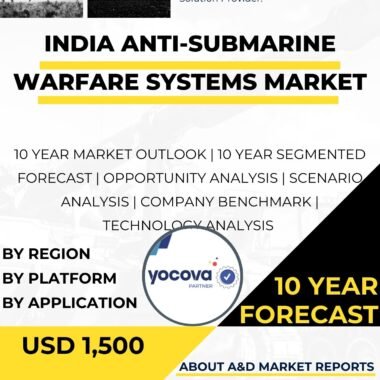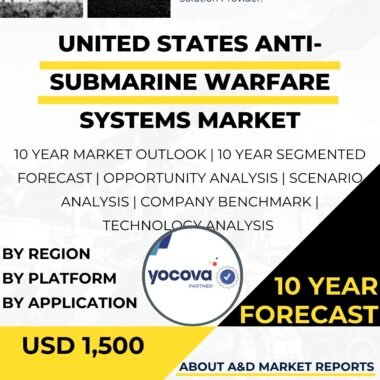Description
Japan Anti-Submarine Warfare Systems Market
The Japan anti-submarine warfare systems market in has witnessed significant growth and strategic importance in recent years, driven by the nation’s focus on enhancing its naval capabilities and addressing security challenges in the maritime domain. ASW systems play a crucial role in detecting, tracking, and countering potential submarine threats, making them essential assets for Japan, a country surrounded by vast waters and faced with increasing regional security concerns.
Japan’s geographical location in the Indo-Pacific region places it in close proximity to potential maritime threats, including submarine activities by neighboring countries. As a result, Japan has prioritized the modernization and development of advanced defense technologies, including ASW systems, to maintain maritime security, safeguard its territorial waters, and ensure the protection of its exclusive economic zone (EEZ).
One of the primary applications of ASW systems in Japan is in the naval domain. The Japan Maritime Self-Defense Force (JMSDF) has integrated advanced ASW technologies into its fleet, significantly enhancing its ability to detect and respond to potential submarine threats. These systems include state-of-the-art sonar systems, underwater sensors, and ASW helicopters, which provide the JMSDF with a comprehensive ASW capability.
Japan’s commitment to indigenous defense capabilities has driven the development of domestically produced ASW systems. Japanese defense companies have been actively engaged in research, development, and production of advanced ASW technologies tailored to Japan’s specific requirements. This collaboration between the government and the domestic defense industry fosters innovation and contributes to the growth of the domestic ASW systems market.
Moreover, Japan’s ASW systems are complemented by its investments in maritime patrol aircraft and maritime surveillance capabilities. Advanced maritime patrol aircraft, equipped with sophisticated ASW sensors and sonobuoys, provide extended reach for Japan’s ASW operations. These aircraft play a crucial role in detecting and tracking submarines, supporting surface vessels in ASW operations, and providing real-time situational awareness in Japan’s maritime domain.
The acquisition of advanced ASW systems also aligns with Japan’s commitment to collective security and regional defense cooperation. As part of its alliances with the United States and other regional partners, Japan has participated in joint military exercises and training to enhance interoperability and coordination in ASW operations. These collaborations strengthen Japan’s ASW capabilities and contribute to regional security and stability.
Additionally, Japan’s ASW modernization efforts are driven by the changing security dynamics in the Indo-Pacific region. The rise of naval activities and the increasing capabilities of regional submarine forces have underscored the importance of maritime security and ASW preparedness. Japan’s maritime interests and freedom of navigation are critical components of its security strategy in response to evolving regional challenges.
Challenges in the ASW systems market in Japan include addressing potential threats from advanced submarine technologies and stealthy underwater capabilities. As adversaries develop more sophisticated submarines with improved stealth characteristics and electronic countermeasures, Japan must continuously upgrade its ASW technologies and tactics to stay ahead of potential threats. This necessitates ongoing research and development efforts to adapt to emerging challenges.
Moreover, cost considerations influence Japan’s ASW systems procurement decisions. Developing and acquiring advanced ASW systems can be expensive, requiring prudent budget allocation and prioritization. Japan must balance investing in cutting-edge technologies with maintaining other critical aspects of its defense capability.
Ensuring the compatibility and integration of ASW systems across different naval vessels and platforms can also be a challenge. Standardizing and optimizing the configuration and deployment of ASW technologies across the JMSDF’s fleet require careful planning and coordination.
In conclusion, the anti-submarine warfare systems market in Japan has experienced significant growth and strategic importance, driven by the nation’s focus on enhancing its naval capabilities and addressing security challenges in the maritime domain. ASW systems play a crucial role in detecting, tracking, and countering potential submarine threats, ensuring maritime security and safeguarding Japan’s territorial waters and exclusive economic zone. The collaboration between the government and the domestic defense industry, as well as international partnerships with allied nations, fosters innovation and contributes to the growth of the domestic ASW systems market. Challenges related to emerging threats, cost considerations, and integration must be addressed to further enhance Japan’s ASW capabilities and ensure its ability to counter potential submarine threats and contribute to regional security and stability in the Indo-Pacific. With its strategic focus on modernizing its naval capabilities, Japan remains committed to maintaining a strong ASW posture and safeguarding its maritime interests in the dynamic and evolving Indo-Pacific region.




